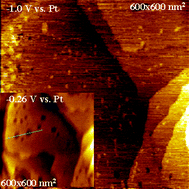On the electrodeposition of titanium in ionic liquids
Abstract
The ability to electrodeposit titanium at low temperatures would be an important breakthrough for making corrosion resistant layers on a variety of technically important materials.

* Corresponding authors
a
Faculty of Natural and Materials Sciences, Clausthal University of Technology, Robert-Koch-Str. 42, Clausthal-Zellerfeld, Germany
E-mail:
frank.endres@tu-clausthal.de
Fax: 0049-5323-722460
b Australian Centre for Electromaterials Science, University of Wollongong, New South Wales, Australia
c Department of Chemistry, Monash University, Victoria, Australia
d Institute of Physical Chemistry, Dresden University of Technology, Dresden, Germany
The ability to electrodeposit titanium at low temperatures would be an important breakthrough for making corrosion resistant layers on a variety of technically important materials.

 Please wait while we load your content...
Something went wrong. Try again?
Please wait while we load your content...
Something went wrong. Try again?
F. Endres, S. Zein El Abedin, A. Y. Saad, E. M. Moustafa, N. Borissenko, W. E. Price, G. G. Wallace, D. R. MacFarlane, P. J. Newman and A. Bund, Phys. Chem. Chem. Phys., 2008, 10, 2189 DOI: 10.1039/B800353J
To request permission to reproduce material from this article, please go to the Copyright Clearance Center request page.
If you are an author contributing to an RSC publication, you do not need to request permission provided correct acknowledgement is given.
If you are the author of this article, you do not need to request permission to reproduce figures and diagrams provided correct acknowledgement is given. If you want to reproduce the whole article in a third-party publication (excluding your thesis/dissertation for which permission is not required) please go to the Copyright Clearance Center request page.
Read more about how to correctly acknowledge RSC content.
 Fetching data from CrossRef.
Fetching data from CrossRef.
This may take some time to load.
Loading related content
